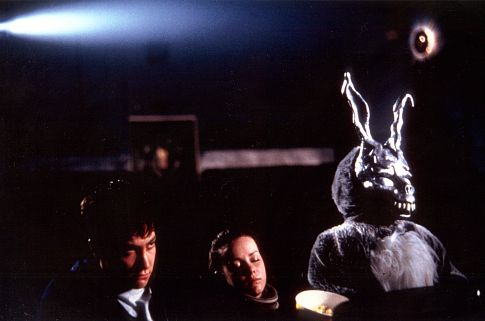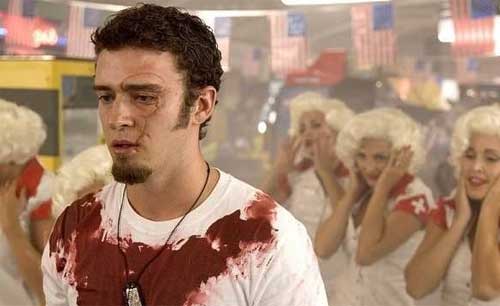
Title: Ghost World
Director: Terry Zwigoff
Released: 2001
Starring: Thora Birch, Scarlett Johansson, Steve Buscemi
Plot: Life long friends and recent High school graduates Enid (Birch) and Rebecca (Johansson) embrace their place as social outcasts and care little for what anyone else thinks about them as they rain down scorn and sarcasm on their peers. However after finding a personal ad placed by the lonely Seymour (Buscemi), their prank call leads Enid to find a kindred spirit in Seymour, as the two start to build an unlikely friendship. Meanwhile Enid finds her own relationship with Rebecca deteriorating as she fights to keep things around her from changing.
Review: It’s time for me to once again revisit another of my all time favourite films. Always a daunting prospect to say the least and mainly because I'm of the mindset that once I review a film that I'm essentially done with it and to write about one of my favourite films means the prospect of never getting to have the pleasure of writing about it again. Still after a recent conversation about films with one my work colleague revealed the horrible truth that there still folks out there who have not seen this film that I knew I had to try and readdress the balance.
Needless to say the assorted colourful characters of “Ghost World” are almost too perfect for Zwigoff, who has made a career out his obsession with misfits, antiheroes and alienation. All themes which he gleefully gets to explore here, especially when these themes are equally popular with Clowes own work making this collaboration the perfect partnership, while Clowes is certainly not afraid to adapt his popular graphic novel, for anyone who has read it will tell you that it is nothing like the film version, outside of perhaps a handful of scenes and its familiar characters. Still the more obsessive fans of Clowes work will no doubt recognise the references to his other comics he has included throughout.
What remains the same though is the bond which Enid and Rebecca share, which is one not so much of close friends, but in fact much closer to a sisterly relationship. A relationship which has been perfectly captured by Birch and Johansson, who truly embody these characters with Birch in particular giving another memorable performance which (her meddling father's career interference aside) only makes you question why she has not been picked up for more mainstream projects rather than working almost exclusively on indie films as she currently is? Johansson on the other hand as we all know would explode into mainstream movies shortly after the release of this film, even though she regularly fails to muster half the laid back talent she showcases so proudly here and later in the equally wonderful “Lost In Translation”
On equally good form is Buscemi, who once again brings his oddball charm to the character of the lovable loser Seymour, a character which Clowes reportedly based in part on director Zwigoff, who in turn had insisted that the character was expanded way beyond his appearance in the original graphic novel, were he shown solely as the victim of the prank call. The similarities between Zwigoff and Seymour only continue through out the film with Seymour’s obsession with 1920’s Blues and Jazz records mirroring Zwigoff’s own obsessions, something which was the focus of his debut film "Louie Bluie". This expansion of his character works only more in the films favour, especially with the graphic novel seemingly being a series of events randomly strung together, while this change instead gives the film a much more structured format and in turn makes the story all the stronger when viewed in this format, for what works as a graphic novel it’s safe to say would not have worked here.
Still the relationship between Enid and Seymour is a fascinating one to watch, as the urge to instantly pair them together is fiercely resisted, with Enid seemingly doing anything she can to help Seymour break out his cocoon of old records and classic nostalgia he has crafted for himself and even when they do get together it is only as a meaningless drunken one night stand, which serves more a catalyst for Enid’s own changing self than it does for their relationship. This however is just one of the numerous risks that the film takes, as it fights against the usual storytelling conventions and somehow never puts a foot wrong.
Though the name “Ghost World” has by Clowes own admittance nothing to do with the story and more to do with the fact that he felt it would be funny to have a bunch of places named after this like Ghost World Elementary. Still Zwigoff has seemingly taken this title in another direction, as he shoots the film almost as if being viewed from a ghosts view point, especially as the camera opens gliding past the windows of Enid’s apartment block, glancing momentarily at each of the various occupants as if choosing who to follow before finally setting in Enid in the throws of her imitation of the dance routine from the bollywood mystery movie “Gumnaam”. Such shooting style continues throughout, with Zwigoff shooting from the position of the onlooker than sat with the characters, while other examples include the extended shot of a video store clerk absentmindedly picking his ear with his pen. Still even though we follow Enid and Rebecca through this journey the audience is still very much left with the feeling of just being ghosts in their world, especially with the films ending seeming so ambiguous on the first viewing.
Unquestionably a hard film to define and in many ways only makes it more like both "Welcome to the Dollhouse" and "Daria" which combine forms an unofficial timeline for Enid, with Dollhouse's Dawn representing Enid in seventh grade, "Daria" her high school years with "Ghost World" representing graduation. I guess all we need now is a film which shows an Enid style character in her wilderness years to further the chain, a film we continue to hold out for.
This is a film which is hard to sell, but easy to fall in love with once viewed, while finally being the high school movie, which will no doubt ring all so true to its fellow misfits and anyone whose felt themselves an outcast.





















No comments:
Post a Comment